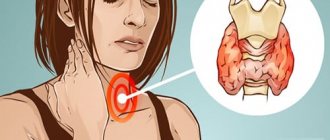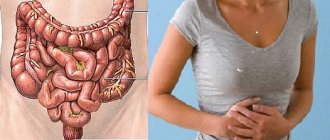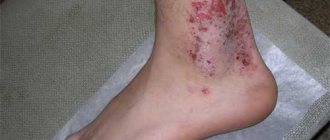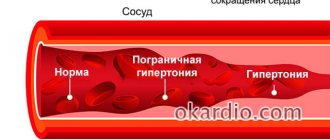A condition when a person develops an acute lack of glucose in plasma and brain tissue begins to starve is called hypoglycemic coma. Pathology often occurs in patients with diabetes; a diabetic coma can have life-threatening consequences, so it is necessary to distinguish the characteristic symptoms and know what first aid will help wait until the ambulance arrives.
What is a hypoglycemic coma characterized by?
We are talking about a critical state of the endocrine system, provoked by a strong drop in blood glucose levels, without which the body is simply unable to function properly due to impaired nutrition of tissues and organs.
Hypoglycemia is fraught with brain hypoxia and loss of consciousness - hypoglycemic coma
Lack of sugar leads to energy starvation of nerve cells, as a result of which their function is disrupted, brain hypoxia develops, protein and carbohydrate metabolism worsens, which in advanced cases is accompanied by loss of consciousness.
Help in such a situation must be provided immediately. But before this, it is advisable to make sure that the developing condition is really a consequence of hypoglycemia.
Kinds
Signs of a diabetic coma depend on its type. The following types of pathology are distinguished:
- hyperglycemic – a condition caused by a sharp increase in blood glucose levels due to various reasons. Hyperglycemic coma is classified into ketoacidotic, hyperosmolar, lactic acidotic;
- hypoglycemic – develops due to a rapid drop in blood glucose levels.
The main symptoms of the pathology will depend on what type of complication the patient has developed.
Causes and factors provoking the condition
The following are the main causes of hypoglycemic coma:
- lack of appropriate therapy for mild hypoglycemia. Every patient diagnosed with diabetes mellitus should be aware of the necessary signs and measures;
- alcohol abuse;
- administration of too large a dose of insulin against the background of a lack of carbohydrates in the body or excessive physical activity. This option is possible if insulin is taken in a higher concentration (100 units instead of 40) or the drug is accidentally administered intramuscularly;
In addition, incorrect dosage calculations may be present if diabetes is accompanied by fatty liver disease or chronic renal failure, which entails slow processing of the hormone administered at the usual dose.
- non-compliance with dietary rules.
Hypoglycemia can be caused by excessive physical activity, poor nutrition, and alcohol.
Hypoglycemic coma can also develop in completely healthy people if the following provoking factors are present:
- psycho-emotional overload, neurosis;
- depression or stress;
- physical overload during intense sports training or hard work.
Another cause of coma can be the presence of a tumor formation in the pancreas (in the islet apparatus) - insulinoma - which causes excessive production of insulin.
The most dangerous of the reasons listed above is an overdose of alcohol, since coma in such situations is often confused with intoxication, occurring several hours after drinking alcohol.
First aid algorithm
Vegetative symptoms are easily eliminated by taking a portion of fast carbohydrates. In terms of glucose, 10-20 grams is usually enough. It is not recommended to exceed this dose, since an overdose can cause the opposite condition - hyperglycemia. To raise blood glucose and improve the patient’s condition, a couple of sweets or pieces of sugar, half a glass of juice or sweet soda are enough. Diabetics usually carry fast carbohydrates with them at all times in order to start treatment on time.
Expert opinion
Shalaeva Svetlana Sergeevna
endocrinologist, highest category, 18 years of experience
Note! If the patient is prescribed acarbose or miglitol, sugar will not be able to stop hypoglycemia , since these drugs block the breakdown of sucrose. First aid for hypoglycemic coma in this case can be provided with pure glucose in tablets or solution.
When the diabetic is still conscious, but can no longer help himself on his own, to relieve hypoglycemia, he is given any sweet drink, making sure that he does not choke. Dry foods at this time pose a risk of aspiration.
If loss of consciousness occurs, you need to call an ambulance, lay the patient on his side, check whether the airways are clear and whether the patient is breathing. If necessary, begin artificial respiration.
Hypoglycemic coma can be completely eliminated even before the arrival of doctors; for this, a first aid kit is required. It includes the drug glucagon and a syringe for its administration. Ideally, every diabetic should carry this kit with them, and their loved ones should be able to use it. This drug can quickly stimulate the production of glucose in the liver, so the patient’s consciousness returns within 10 minutes after the injection.
Exceptions are coma due to alcohol intoxication and multiple excess doses of insulin or glibenclamide. In the first case, the liver is busy cleansing the body of alcohol breakdown products, in the second, the glycogen reserves in the liver will not be enough to neutralize insulin.
Stages and signs of hypoglycemic coma
As noted, coma is a consequence of gradually developing hypoglycemia. Based on the nature of the damage to the nervous system, autonomic and neuroglycopenic symptoms of this condition are distinguished.
The vegetative form is characterized by the following manifestations:
- aggressive state with increased excitability;
- unreasonable feelings of anxiety, fear, restlessness;
- increased activity of sweat glands and muscle tremors;
- jump in blood pressure;
- pale skin and dilated pupils;
- arrhythmia;
- increased muscle tone;
- nausea, which may be accompanied by vomiting and general weakness;
- strong feeling of hunger.
It is important to recognize the symptoms of hypoglycemia in time to prevent the development of hypoglycemic coma
A feature of the neuroglycopenic form is the presence of the following symptoms:
- decreased concentration;
- the appearance of dizziness and headache;
- violation of orientation in space;
- double vision;
- memory loss and inappropriate behavior;
- breathing disorder;
- feeling drowsy;
- fainting or pre-syncope.
Signs of hypoglycemic coma vary depending on the stage of the process. The presence of certain symptoms is due to gradual damage to parts of the central nervous system. The sequence is as follows: cerebral cortex - subcortical structures - cerebellum - medulla oblongata.
Hyperglycemia is diagnosed when blood sugar is below 3.9 mmol/l
There are 5 successive stages:
- At the initial stage, there is a change in mood, increased excitability or the opposite state in the form of anxiety, depression. Simultaneously with psycho-emotional disorders, a headache appears, muscle weakness is observed, a feeling of hunger is clearly felt, the skin is too moisturized, and tachycardia begins to develop.
- If a hypoglycemic coma enters the second stage, the face becomes noticeably red, vision begins to double, and the sweat glands work too actively. The patient's behavior becomes inadequate due to the addition of movement disorders.
- The third stage is almost similar in course to an epileptic seizure due to the appearance of convulsions, excessive increase in muscle tone, and dilated pupils.
- It is at the fourth stage that the comatose state occurs directly. Loss of consciousness occurs, dilated pupils, increased heart rate, and increased skin moisture are noted. A slight increase in temperature is possible.
- If a hypoglycemic coma enters the last stage, the patient's condition becomes critical due to decreased muscle tone, a drop in blood pressure and heart rhythm disturbances.
Symptoms in children
In childhood, signs of hypoglycemia are manifested in the following:
- at an early stage, children often experience a strong feeling of hunger;
- possible complaints of general weakness and trembling of the whole body;
- sweating often increases, tachycardia develops, the face turns red or pale;
- Rare symptoms include headaches, abdominal discomfort, nausea;
- a young child may have causeless tearfulness, excessive aggressiveness, and refusal to eat is possible.
In both children and adults, hypoglycemic coma is often accompanied by numbness of the lips or tip of the tongue. This phenomenon is called paresthesia.
Diagnostic features
The basis for diagnosing hypoglycemic coma is the patient’s anamnesis (medical history), the clinical picture available at the time of examination and laboratory data. The most important test is an emergency determination of blood sugar levels.
The diagnosis of hypoglycemia in children is carried out extremely carefully, for whom the development of the described condition is typical even against the background of hyperglycemia, if there is a sharp drop in glucose levels.
Other tests may be performed, including determining the level of ketone bodies and acetone in the urine, acid-base status. But such studies are considered unspecific.
To determine the type of coma in a hospital setting, about 50 ml of a glucose solution with a concentration of 40% is injected into a vein. With a mild course, the patient’s condition quickly normalizes.
Differential diagnosis
Hypoglycemic coma has similar symptoms to other similar conditions, including ketoacidotic (caused by hyperglycemia, increased levels of ketone bodies) and lactic acidotic (caused by a sharp increase in lactic acid levels in the blood) coma.
How to differentiate coma from other pathologies - table
| Condition assessment criteria | Type of coma | ||
| Hypoglycemic | Lactic acidotic | Ketoacidotic | |
| How quickly does a coma develop? | For a few minutes. | During few hours. | For 3–7 days, in the presence of an inflammatory process in the body - a maximum of a day. |
| Provoking factors | Poor eating habits, excessive insulin administration, alcohol consumption, or unplanned physical activity. | The development of hypoxia against the background of anemia, heart or pulmonary failure, the presence of serious liver pathologies, taking in excess of biguanide-based drugs. | Failure to follow the technique of administering insulin or stopping its supply to the body, surgery, stress or injury, pregnancy. |
| Skin and breathing | The skin is pale and very moisturized, breathing may become slightly faster. | Kussmaul breathing is noted with deep inhalation and forced exhalation, accompanied by loud noise, the skin is dry. | |
| Blood pressure readings | Blood pressure remains normal or increases. | A strong decline with the possibility of collapse. | Decreasing. |
| The smell of acetone in the exhaled air | Not diagnosed. | Not diagnosed. | Explicitly expressed. |
| Condition of the eyeballs | The tone remains within normal limits. | A slight decrease in tone is possible. | The tone is noticeably reduced. |
| Special signs | As the condition worsens, warning symptoms appear in the form of palpitations, tremors, paroxysmal sweating, pale skin, loss of consciousness and convulsions. | There is a rapid progression of cardiovascular failure, dehydration against the background of metabolic disorders, skin turgor decreases, the tone of the eyeballs decreases, and the mucous membranes dry out. | There are signs of dehydration with dry skin and mucous membranes, decreased tissue turgor, ketoacidosis develops, diagnosed by the obvious smell of acetone from the mouth, nausea, abdominal pain and vomiting often occur. |
Organization of treatment
Not in every case the state of hypoglycemia ends in the development of coma. If, after the first signs in the form of sudden weakness, trembling of the limbs, sweating, palpitations and a feeling of heat, unbearable hunger, the intake of glucose into the body is ensured (1-2 pieces of sugar, sweet tea with bread are enough), the symptoms completely go away. In more severe situations, an integrated approach is required with the use of emergency measures and hospital therapy.
Therapy for hypoglycemia is carried out depending on the severity of the condition
Emergency measures
Such help is needed in case of fainting and loss of consciousness.
- The patient must be placed on his side and any remaining food is removed from the mouth.
- If the ability to swallow remains, give a warm sweet drink (2 tablespoons of sugar per 100 ml of water), you can put a piece of sugar behind the cheek.
- If you have a syringe tube with glucagon on hand, 1 ml of the drug is injected subcutaneously and wait for the ambulance team to arrive.
Specialists first administer intravenous glucose solution to determine the type of coma. With further absence of consciousness, they begin to drip glucose into a vein (the concentration of the solution is 5–10%) and transport the patient to the hospital. Simultaneously with glucose, subcutaneous administration of a 0.1% adrenaline solution is often practiced.
How to relieve symptoms of hypoglycemia - video
Taking medications
In a hospital setting, cardiovascular pathologies and traumatic brain injuries are immediately excluded and provoking factors are identified.
- If there has been an overdose of insulin tablets, proceed to gastric lavage, after which the body is cleansed with activated charcoal.
- When administering excess insulin by injection (if it was done a maximum of 3 hours before hospitalization), excision of the injection site is required. During this therapy, a glucose solution is constantly injected dripwise, achieving normalization of blood sugar levels. To prevent excess fluid from entering the body, glucose is infused alternately at a concentration of 10 and 40%.
Treatment of severe hypoglycemia when effective intravenous glucose administration is not possible consists of subcutaneous injection of a solution of glucagon or epinephrine. The effectiveness of such therapy depends on how much glycogen is accumulated in the liver. As soon as a positive reaction is noted, additional carbohydrates are started to be administered to prevent secondary hypoglycemia.
During the treatment of hypoglycemia, blood tests should be performed regularly.
In case of prolonged hypoglycemia, special attention is paid to preventing the development of ketoacidosis, for which crystalline insulin is administered in small doses, while simultaneously monitoring sugar levels in urine and blood tests. Prolonged absence of consciousness is an indication for intramuscular administration of glucagon every 2 hours and drip administration of glucocorticoids four times a day. The administration of manitol is also practiced.
In order for glucose to be maximally absorbed by the body, at any stage of coma the administration of cocarboxylase and a 5% solution of ascorbic acid is indicated. On the recommendation of a doctor, additional intake of humidified oxygen, vascular and cardiac medications is possible.
Dietary ration
Anyone diagnosed with diabetes should be careful about their diet, excluding large amounts of carbohydrate foods. When symptoms of hypoglycemia appear, easily digestible carbohydrates are especially dangerous, since while the islet apparatus of the pancreas remains active, a rapid deterioration of the condition is possible. When signs of hypoglycemia are eliminated, a standard diabetic diet is prescribed.
Treatment
Hypoglycemic coma is a dangerous pathological condition that requires qualified medical care. Self-medication and the use of traditional medicine methods in this case will only aggravate the situation and lead to complications. Such measures are strictly prohibited.
The patient is hospitalized in a coma. To stabilize the condition, 20–60 ml of a 40% dextrose solution is injected intravenously. If the patient does not regain consciousness within 20 minutes, a 5–10% dextrose solution is administered to him using a dropper until he feels better.
In particularly difficult cases, resuscitation methods are used. To prevent cerebral edema, Prenisolone at a dosage of 30–60 mg or Dexamethasone (4–8 mg), as well as diuretics (Furosemide, Mannitol or Mannitol), are indicated. If the unconscious state persists for a long time, the patient is transferred to artificial ventilation and more serious treatment is prescribed.
After the patient is brought out of the hypoglycemic coma, he is transferred to the hospital. Constant medical monitoring will allow timely detection, elimination or prevention of disorders of the central nervous system. Additionally, the cause of hypoglycemia is determined, nutrition is adjusted, and the optimal insulin level is selected.
With timely and effective treatment of hypoglycemic coma, the patient returns to consciousness, glucose levels stabilize and all negative symptoms disappear. However, sometimes a coma does not go away without a trace. In children, it causes serious problems with the central nervous system, respiratory failure and cardiovascular failure. In older people, it provokes the development of myocardial infarction or stroke, so after stopping an acute attack, you should definitely do an electrocardiogram.
Complications and possible consequences
If the hypoglycemic coma is not prolonged, the prognosis for most patients is very favorable due to the reversibility of neurological disorders. But irreversible changes, manifested in the form of a decrease in mental activity, are also possible.
Staying in a coma for more than 4 hours is especially dangerous. In this case, the likelihood of cerebral edema increases, which can lead to disability or even death.
Frequent attacks of hypoglycemia, which provoke personality changes, also have a negative impact on the general condition. Long-term consequences include encephalopathy, parkinsonism, and epilepsy.
The list of possible complications includes cardiovascular pathologies - stroke, myocardial infarction (especially if there is a history of coronary artery disease). Therefore, after recovery from a coma, an ECG is necessarily prescribed. It must be remembered that changes may appear after a couple of months.
Prevention: how to prevent a life-threatening condition
To prevent hypoglycemic coma, people with diabetes need to follow the following rules:
- Taking the insulin drug should be carried out strictly on time.
- It is important to strictly follow the diet and dosage of physical activity.
- Stressful situations are excluded.
- When going to work or for a walk, you need to have sugar, a piece of bread or candy with you.
- Due to the possible loss of consciousness when leaving the house, it is important to have any document or note confirming the presence of diabetes.
As they say, forewarned is forearmed. In the case of hypoglycemic coma, this phrase is especially appropriate, because knowledge of preventive measures and the first symptoms allows you to stop the attack in time, preventing loss of consciousness and serious complications.











